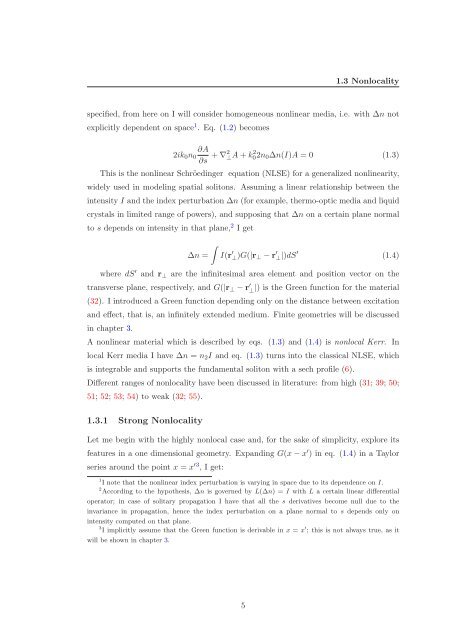Solitons in Nonlocal Media
Solitons in Nonlocal Media
Solitons in Nonlocal Media
Create successful ePaper yourself
Turn your PDF publications into a flip-book with our unique Google optimized e-Paper software.
1.3 <strong>Nonlocal</strong>ity<br />
specified, from here on I will consider homogeneous nonl<strong>in</strong>ear media, i.e. with ∆n not<br />
explicitly dependent on space 1 . Eq. (1.2) becomes<br />
∂A<br />
2ik0n0<br />
∂s + ∇2⊥ A + k2 02n0∆n(I)A = 0 (1.3)<br />
This is the nonl<strong>in</strong>ear Schröed<strong>in</strong>ger equation (NLSE) for a generalized nonl<strong>in</strong>earity,<br />
widely used <strong>in</strong> model<strong>in</strong>g spatial solitons. Assum<strong>in</strong>g a l<strong>in</strong>ear relationship between the<br />
<strong>in</strong>tensity I and the <strong>in</strong>dex perturbation ∆n (for example, thermo-optic media and liquid<br />
crystals <strong>in</strong> limited range of powers), and suppos<strong>in</strong>g that ∆n on a certa<strong>in</strong> plane normal<br />
to s depends on <strong>in</strong>tensity <strong>in</strong> that plane, 2 I get<br />
<br />
∆n =<br />
I(r ′ ⊥ )G(|r⊥ − r ′ ⊥ |)dS′<br />
(1.4)<br />
where dS ′ and r⊥ are the <strong>in</strong>f<strong>in</strong>itesimal area element and position vector on the<br />
transverse plane, respectively, and G(|r⊥ − r ′ ⊥ |) is the Green function for the material<br />
(32). I <strong>in</strong>troduced a Green function depend<strong>in</strong>g only on the distance between excitation<br />
and effect, that is, an <strong>in</strong>f<strong>in</strong>itely extended medium. F<strong>in</strong>ite geometries will be discussed<br />
<strong>in</strong> chapter 3.<br />
A nonl<strong>in</strong>ear material which is described by eqs. (1.3) and (1.4) is nonlocal Kerr. In<br />
local Kerr media I have ∆n = n2I and eq. (1.3) turns <strong>in</strong>to the classical NLSE, which<br />
is <strong>in</strong>tegrable and supports the fundamental soliton with a sech profile (6).<br />
Different ranges of nonlocality have been discussed <strong>in</strong> literature: from high (31; 39; 50;<br />
51; 52; 53; 54) to weak (32; 55).<br />
1.3.1 Strong <strong>Nonlocal</strong>ity<br />
Let me beg<strong>in</strong> with the highly nonlocal case and, for the sake of simplicity, explore its<br />
features <strong>in</strong> a one dimensional geometry. Expand<strong>in</strong>g G(x − x ′ ) <strong>in</strong> eq. (1.4) <strong>in</strong> a Taylor<br />
series around the po<strong>in</strong>t x = x ′3 , I get:<br />
1 I note that the nonl<strong>in</strong>ear <strong>in</strong>dex perturbation is vary<strong>in</strong>g <strong>in</strong> space due to its dependence on I.<br />
2 Accord<strong>in</strong>g to the hypothesis, ∆n is governed by L(∆n) = I with L a certa<strong>in</strong> l<strong>in</strong>ear differential<br />
operator; <strong>in</strong> case of solitary propagation I have that all the s derivatives become null due to the<br />
<strong>in</strong>variance <strong>in</strong> propagation, hence the <strong>in</strong>dex perturbation on a plane normal to s depends only on<br />
<strong>in</strong>tensity computed on that plane.<br />
3 I implicitly assume that the Green function is derivable <strong>in</strong> x = x ′ ; this is not always true, as it<br />
will be shown <strong>in</strong> chapter 3.<br />
5
















